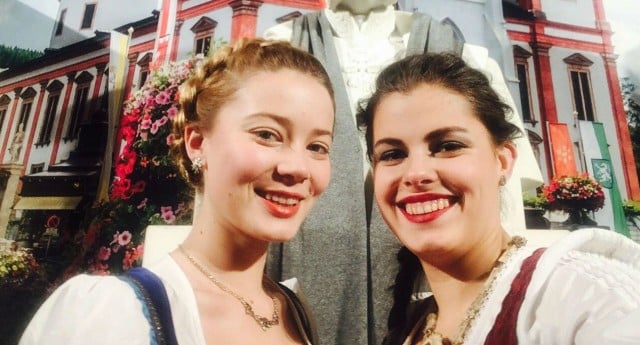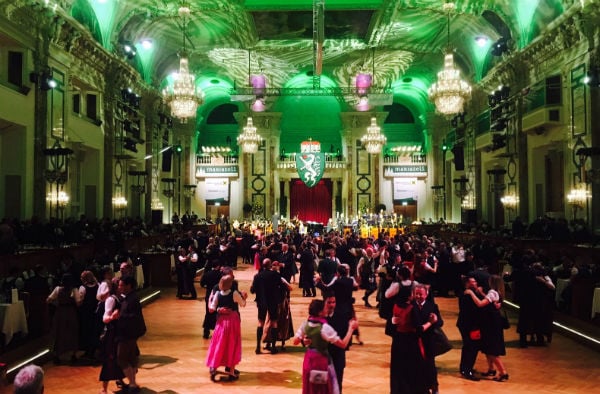What you need to know before attending a Viennese ball

Ball season is in full swing in Vienna - and to the uninitiated a Vienna ball can seem like an intimidating event. But they aren’t the stuffy, elitist affairs you might think, and can be a whole lot of fun. Here’s what you need to know before accepting an invitation, or purchasing a ticket to your first ball.
The Local spoke to Vienna local Matthias Brandstetter, who’s something of an expert on ball etiquette. He used to be a dance teacher and helped organise balls in Vienna, as well as hosting a Viennese ball in Thailand. He’s now running a real estate website called toprop.com
Here’s his tips for making the most out of a Viennese ball.
Do master some dance steps.
Most Austrian school students attend dancing lessons to prepare for what is the equivalent of a prom. Brandstetter says it’s a good idea to familiarise yourself with the Viennese Waltz (easier if you’re a woman, as you don’t have to lead) but he recommends also practising the foxtrot and the boogie as these tend to be common dances at most balls. The bigger Viennese balls will have an orchestra and a big band, so you can enjoy a variety of dances. At midnight, it’s common to dance the fin de siècle quadrille, which peaked in popularity in the late 1800s. If you want to go to a ball but don’t have a partner to dance with, you can even hire one! These are known as ‘Taxitänzer’ (and tend to be male). Some balls will even employ a Taxitänzer for the night.
Do dress appropriately.
It will say what the dress code is on your ball ticket. Usually it’s a tuxedo or white tie (Frack) for men, and a formal, floor-skimming dress for women. “It’s awkward to show up to a ball wearing a dress that’s too short, and people do get sent home if they’re not dressed properly,” Brandstetter says.
Men are required to wear bow ties, rather than ties, and it’s usually mandatory for men to carry white gloves if they are wearing full evening dress. Brandstetter explains that in former times men wore white gloves at balls as it was considered rude to touch a lady with your bare hands, especially if you had become sweaty from dancing!

Two Viennese beauties at the Styrian Ball. Photo: Denise Pavlik
Do have fun!
Remember to enjoy the night. It’s about the memories you take home with you, not how good you are on the dance floor, Brandstetter says. “Have a look at what everybody else is doing and join in the fun.” At a smaller, less formal ball this could mean joining in some riotous disco dancing or limbo at some point during the night.
Get tipsy, but not drunk.
The food and drink at most Vienna balls tends to be on the expensive side - which is good as it’s not the done thing to get roaring drunk at a ball and pass out on the dance floor. Young Viennese people have been known to carry a hip flask filled with something strong but that’s generally a no-no.
Don’t drive to the ball.
Brandstetter recommends booking a taxi or taking the U-Bahn (subway train). Part of the fun of the Vienna ball season is seeing people parading around the city in their finest clothes. It’s also nice to go to a traditional coffee house on the way home for breakfast - many will stay open all night during ball season, or open very early. Brandstetter says Cafe Schwarzenberg is a favourite, as is Cafe Landtmann - but do make a reservation.
Brandstetter’s favourite ball is the Kaffeesieder Ball (which takes place on February 17th this year), and honours the guild of Coffee House Owners. He says it’s one of Vienna’s most beautiful and atmospheric balls, held in the imperial Hofburg palace. “The whole Hofburg is open and you can really explore it. But it’s not incredibly formal and has a down-to-earth feel. You can buy a ticket at most coffee houses in Vienna.” (Tickets cost €135).

The recent Styrian Ball at the Hofburg. Photo: Shoshana Stark
He recommends choosing a ball that you’re interested in. There’s a ball in every Vienna district, for every organisation - from the Red Cross, to the fire brigade, and the lawyers and scientists guilds. The smaller balls tend to be less formal and elegant but are more about dancing, meeting people, and networking. The very formal balls, such as the legendary Opera Ball (23rd February), can be impossible to get a ticket to and are of course more exclusive and expensive.
For a different but very Austrian experience, Brandstetter recommends the Hunters Ball or Jägerball (30th January). Everyone wears traditional Austrian dress, a Dirndl for women and a Trachtenanzug for men. Brandstetter says these tend to be very flattering to most shapes and sizes, and are also more comfortable than formal evening wear, so you can enjoy the dancing even more.
The Bonbon Ball (24th February) is held at the Wiener Konzerthaus and is known for its fun and informal ambiance. It tends to attract a younger crowd.
At the Vienna Boys' Choir Ball (27th January) guests not only dance to the waltz but also to plenty of samba and bossa nova, as this year's host country is Brazil. And, of course, the Vienna Boys' Choir opens the ball with a performance.
Comments
See Also
The Local spoke to Vienna local Matthias Brandstetter, who’s something of an expert on ball etiquette. He used to be a dance teacher and helped organise balls in Vienna, as well as hosting a Viennese ball in Thailand. He’s now running a real estate website called toprop.com
Here’s his tips for making the most out of a Viennese ball.
Do master some dance steps.
Most Austrian school students attend dancing lessons to prepare for what is the equivalent of a prom. Brandstetter says it’s a good idea to familiarise yourself with the Viennese Waltz (easier if you’re a woman, as you don’t have to lead) but he recommends also practising the foxtrot and the boogie as these tend to be common dances at most balls. The bigger Viennese balls will have an orchestra and a big band, so you can enjoy a variety of dances. At midnight, it’s common to dance the fin de siècle quadrille, which peaked in popularity in the late 1800s. If you want to go to a ball but don’t have a partner to dance with, you can even hire one! These are known as ‘Taxitänzer’ (and tend to be male). Some balls will even employ a Taxitänzer for the night.
Do dress appropriately.
It will say what the dress code is on your ball ticket. Usually it’s a tuxedo or white tie (Frack) for men, and a formal, floor-skimming dress for women. “It’s awkward to show up to a ball wearing a dress that’s too short, and people do get sent home if they’re not dressed properly,” Brandstetter says.
Men are required to wear bow ties, rather than ties, and it’s usually mandatory for men to carry white gloves if they are wearing full evening dress. Brandstetter explains that in former times men wore white gloves at balls as it was considered rude to touch a lady with your bare hands, especially if you had become sweaty from dancing!

Two Viennese beauties at the Styrian Ball. Photo: Denise Pavlik
Do have fun!
Remember to enjoy the night. It’s about the memories you take home with you, not how good you are on the dance floor, Brandstetter says. “Have a look at what everybody else is doing and join in the fun.” At a smaller, less formal ball this could mean joining in some riotous disco dancing or limbo at some point during the night.
Get tipsy, but not drunk.
The food and drink at most Vienna balls tends to be on the expensive side - which is good as it’s not the done thing to get roaring drunk at a ball and pass out on the dance floor. Young Viennese people have been known to carry a hip flask filled with something strong but that’s generally a no-no.
Don’t drive to the ball.
Brandstetter recommends booking a taxi or taking the U-Bahn (subway train). Part of the fun of the Vienna ball season is seeing people parading around the city in their finest clothes. It’s also nice to go to a traditional coffee house on the way home for breakfast - many will stay open all night during ball season, or open very early. Brandstetter says Cafe Schwarzenberg is a favourite, as is Cafe Landtmann - but do make a reservation.
Brandstetter’s favourite ball is the Kaffeesieder Ball (which takes place on February 17th this year), and honours the guild of Coffee House Owners. He says it’s one of Vienna’s most beautiful and atmospheric balls, held in the imperial Hofburg palace. “The whole Hofburg is open and you can really explore it. But it’s not incredibly formal and has a down-to-earth feel. You can buy a ticket at most coffee houses in Vienna.” (Tickets cost €135).

The recent Styrian Ball at the Hofburg. Photo: Shoshana Stark
He recommends choosing a ball that you’re interested in. There’s a ball in every Vienna district, for every organisation - from the Red Cross, to the fire brigade, and the lawyers and scientists guilds. The smaller balls tend to be less formal and elegant but are more about dancing, meeting people, and networking. The very formal balls, such as the legendary Opera Ball (23rd February), can be impossible to get a ticket to and are of course more exclusive and expensive.
For a different but very Austrian experience, Brandstetter recommends the Hunters Ball or Jägerball (30th January). Everyone wears traditional Austrian dress, a Dirndl for women and a Trachtenanzug for men. Brandstetter says these tend to be very flattering to most shapes and sizes, and are also more comfortable than formal evening wear, so you can enjoy the dancing even more.
The Bonbon Ball (24th February) is held at the Wiener Konzerthaus and is known for its fun and informal ambiance. It tends to attract a younger crowd.
At the Vienna Boys' Choir Ball (27th January) guests not only dance to the waltz but also to plenty of samba and bossa nova, as this year's host country is Brazil. And, of course, the Vienna Boys' Choir opens the ball with a performance.
Join the conversation in our comments section below. Share your own views and experience and if you have a question or suggestion for our journalists then email us at [email protected].
Please keep comments civil, constructive and on topic – and make sure to read our terms of use before getting involved.
Please log in here to leave a comment.